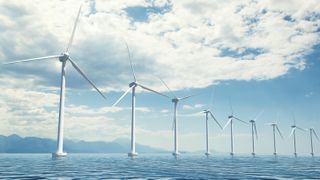Floating wind turbines could power a new green energy revolution
The innovative designs have the potential to harness large amounts of renewable energy in the middle of the ocean

Floating windfarms could become a significant source of renewable energy according to experts, thanks to the potential they have for harnessing larger amounts in deeper waters.
Currently, the world’s first floating windfarm - located in the North Sea just off Scotland’s Aberdeenshire coast – is proving to be a notable success and recently broke UK records for its energy output. The 30-megawatt facility is owned and operated by Norwegian firm Equinor and there are now calls to create more of them around the world as fossil fuels continue to be phased out.
Increased production of wind energy could then lead to more availability of renewables, which in turn could drive down wholesale prices and energy bills, while also benefiting the environment. However, there are some logistical obstacles and challenges in the way that will need to be overcome before the farms can be mass produced.
- Looking for a green energy tariff? See the best deals in your area now
How do the windfarms work and what are the challenges?
The majority of our offshore windfarms are on fixed foundations that anchor them down onto the seafloor. This means their positioning in the water is limited to depths of around 165ft.
The floating turbines are instead towed out to sea and tethered to the seabed with mooring lines. However, these structures are typically much larger in size and they come in three different designs. The most common is the ‘spar buoy’ design (which is what the farm off the coast of Scotland uses). This has a weighted cylinder plunging into the sea up to 75 meters below the surface. This then acts as a counterbalance to the turbine, which stands at a huge 175 meters in the air.
It’s their large size, plus the fact they can be positioned in deeper water where according to reports ‘close to 80% of potential offshore wind is found’, which makes them more effective at energy generation. What’s more, they can be moved and repositioned to follow weather patterns and to avoid issues with those who don’t like their impact on the natural scenery.
While there are the obvious benefits of increasing green energy production by using floating turbines, there are a few significant hurdles that need to be overcome before they can be built on a mass scale.
Get daily insight, inspiration and deals in your inbox
Get the hottest deals available in your inbox plus news, reviews, opinion, analysis and more from the TechRadar team.
These are:
- The cost. Right now, floating farms are twice as expensive to make as their anchored offshore counterparts.
- The design. As there’s no universally agreed upon and uniform design for the turbines, it’s harder to drive down production costs.
- Objections from the fishing industry. Some have expressed concern that floating farms could obstruct fishing areas and subsequently damage the livelihoods of those working in the sector.
The wider potential benefits of floating farms
At present, the International Energy Agency (IEA) believes that for global carbon neutrality by 2050, offshore wind power needs to account for upwards of 80GW of worldwide energy. This is something the increased production from floating farms could facilitate, should the above issues be resolved and further investment in the farms is put forward.
There are some plans for further floating farms around the UK as well as in America. The California government is planning to offer ‘commercial leases for Morro Bay and Humboldt Bay’ next year for new turbines, with the belief that it will also bring more clean energy jobs to the state, as well as reduce pollution levels and ease the transition away from natural gas.
Hopefully these projects will be green-lit sooner rather than later and more nations will follow suit in the fight for carbon neutrality. How quickly the typical household will see the benefits of cheaper renewable energy though does still remain to be seen, but that’s not to say there aren’t affordable green tariffs on offer right now.
If you do want to be more environmentally conscious with your energy, you should run an online energy comparison to find the best energy deals near you and then switch to a tariff that uses 100% renewables, or one with a greener fuel mix. By switching, you can also end up making big savings and a comparison service can show you just how much cheaper your bills will be and what's on offer from some of the best energy suppliers on the markets right now.
Find the best energy deal for your home
TechRadar has partnered with GoCompare to help you find the best energy deals in your area. Our energy comparison tool takes less than five minutes to use, and could save you hundreds on your energy bills. Save money now
Rich is a freelance copywriter and content strategist with over 10 years' experience. His career has seen him work in-house and in various agencies, producing online and offline content marketing campaigns and copywriting for clients in the energy industry.


